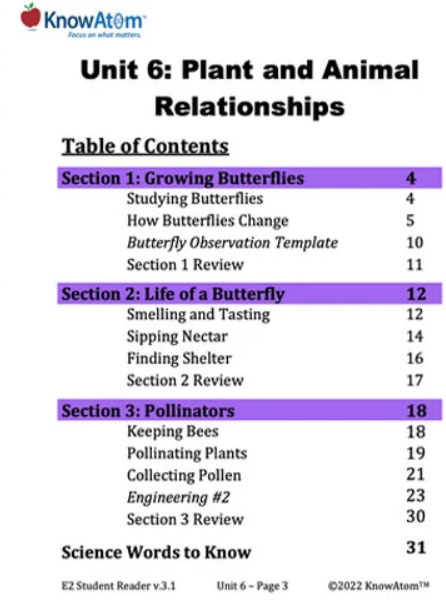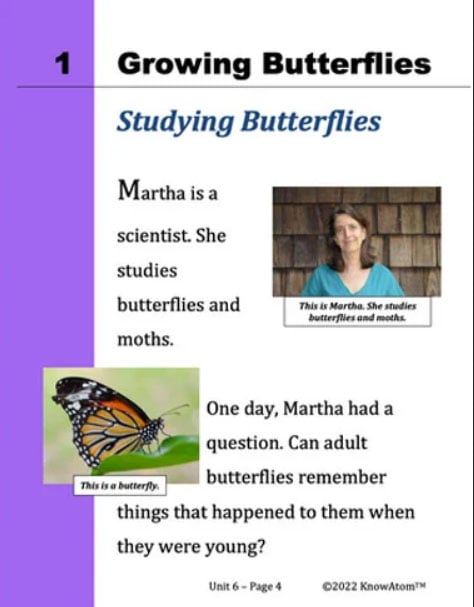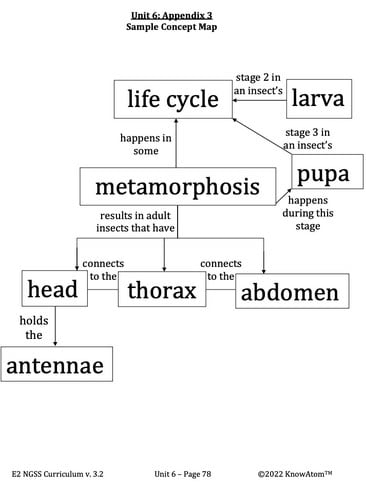In the third lesson, students apply what they have learned about plants, animals, and pollination to design a hand pollinator that mimics the body structures of a pollinator to move pollen from one flower to another.
In this unit, students continue to explore the phenomena of living things, focusing on animals. They begin by observing the metamorphosis of a butterfly and then model the parts of a butterfly that help it survive in its environment. This page provides an overview of key components of this lesson that has students applying what they know about pollination to design a self-pollinating technology.
This background information is helpful for teachers to have more in-depth information about the topic being studied by students.
Bees are among the most effective pollinators. Honeybees play an important role in agriculture because they pollinate the flowers of one third of all fruits and vegetables that we eat. They contribute to more than $14 billion of U.S. crop production, pollinating crops of almonds, blueberries, melons, broccoli, and apples. Because of their important role in the food chain, there are an estimated 2.4 million honeybee colonies in the U.S. today. Two- thirds of those colonies travel the country each year pollinating crops and producing honey and beeswax.
Bees have different body structures that make them such effective pollinators. They are covered with many small hairs, making them fuzzy so pollen sticks to them as they eat the nectar of flowering plants. Female bees also have a basket on their back legs for holding pollen. Some birds are also pollinators. Hummingbirds are one kind of pollinator. They have long, thin beaks that they use to reach their beaks into flowers to get nectar. Pollen gets on their faces, and then drops off when they fly to another plant.
In the third lesson, students apply what they have learned about plants, animals, and pollination to design a hand pollinator that mimics the body structures of a pollinator to move pollen from one flower to another.

Prepared hands-on materials, full year grade-specific curriculum, and personalized live professional development designed to support mastery of current state science standards.
Abdomen: the back segment of an insect where the stomach is
Antennae: body parts of insects that are used to smell, touch, and taste things
Larva : an insect’s young, worm-like form; a caterpillar for butterflies and moths
Pupa: the inactive stage of an insect when it changes; does not eat
Head: the front segment of an insect where the antennae, mouthparts, and eyes are found
Life cycle: the stages an organism passes through on its way from birth to death
Metamorphosis – when a living thing completely changes its form from one stage to the next in its life cycle
Thorax: the middle segment of an insect where the legs and wings are found
Pollinating Plants
Many people raise bees. Bees are important for people. Bees make honey that people eat.
People also use bees to pollinate plants. Bees are good pollinators. They pollinate many plants. Bees pollinate many kinds of fruits and vegetables that people eat.
Many plants cannot make new plants without pollinators. Flowers use pollen to make seeds. The pollinators move the pollen to where it needs to go.
Pollinators move pollen from the stamens of one flower to the pistil of another. When the pollen reaches the pistil, new seeds can be made.
Collecting Pollen
Bees have body parts that collect pollen.Bees have fuzzy bodies. They are covered with many small hairs. Pollen sticks to these hairs when bees eat nectar. Some bees have a basket on their back legs. This basket holds pollen.
Insects aren’t the only pollinators. Some birds are also pollinators. Hummingbirds are pollinators. They have long, thin beaks. They reach their beaks into the flowers.
Some pollen from the flower gets on their face. They fly to another plant. Some of the pollen drops off onto this plant. It can now form seeds.



In this lesson, students summarize a problem presented in an engineering scenario, which is that insects are not pollinating the flowers in Kia’s garden. Students then identify criteria and constraints before designing their own prototype solution. Once students build their hand pollinator prototype, they test it to determine how well it solved the problem. Students collect and analyze data on how many pollen grains they could pick up with each of their prototype solutions, looking for evidence in their data about which prototype best solved the problem. Student teams present to the class their explanation about whether they would refine or replicate their prototype design. Different teams engage in scientific argumentation about which features best solved the problem, as well as any challenges they encountered.
KnowAtom incorporates formative and summative assessments designed to make students thinking visible for deeper student-centered learning.


Discover hands-on screens-off core science curriculum for student centered K-8 classrooms. KnowAtom supports classrooms with all hands-on materials, curriculum, and professional development to support mastery of the standards.
Standards citation: NGSS Lead States. 2013. Next Generation Science Standards: For States, By States. Washington, DC: The National Academies Press. Neither WestEd nor the lead states and partners that developed the Next Generation Science Standards were involved in the production of this product, and do not endorse it.
